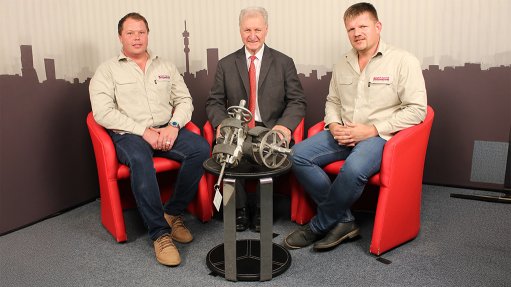Epson launches new range of low-power business printers as factories set to go green
Printing equipment manufacturer Epson has launched a new range of energy efficient, heat-free inkjet printers for business use that can print from 40 to 60 pages per minute and use up to 83% less power than comparable laser printers.
Further, the company has said its production factories will transition to using only renewable energy during the year.
"We made a commitment to adopt 100% renewables by the end of 2023, with one of the key factors being that we own all the factories and environments that produce the finished Epson products," Epson Southern Africa country manager Timothy Thomas said during a briefing on February 22.
"Further, by 2030, we will have reduced greenhouse-gas emissions in line with the 1.5 °C warming scenario and, by 2050, we will be carbon-negative and produce products that are underground resource-free," he added.
Epson is focusing on reducing the environmental impact of its products and services. It is also focusing on supporting its ecosystem, including service providers, he noted.
The company had its group environmental targets verified with various international organisations, including the private sector climate action organisation the Science Based Targets initiative (SBTi), he added.
The company does rely on other manufacturers for some components, but it has a vested interest in their sustainability. It, therefore, conducts supplier evaluations and audits and has a code of conduct for suppliers of parts that contribute to the finished products, Thomas pointed out.
Meanwhile, the AM-C range of printers has no fuse units to preheat and then to fuse the ink to the page, which were the most energy-intensive parts of laser printing. This also meant that there was no warm-up time with the new printers, said Epson South Africa office automation sales manager Yudheer Harbhajun.
"By reducing energy intensity by up to 83%, the AM-C series can run off a normal office 2 kVA uninterruptible power supply for four hours. Its low energy consumption also helps to reduce the required size of renewable energy systems for offices transitioning to renewables," he said.
Inkjet printers were also easier to maintain, which was confirmed by Epson's customers in a survey, and the new range of AM-C printers has only 42 parts, thereby reducing maintenance, he added.
The printers achieve resolutions of 2 400 x 600 dots per inch. The Epson Micro Piezo printheads achieve high placement accuracy with fast ejection of up to 50 000 droplets per second by controlling the meniscus at the tip of each nozzle and using variable size dot technology, he noted.
Piezo printing technology applies voltage to change the shape of piezoelectric elements, the mechanical motion of which ejects the ink. By depositing microscopic droplets of ink directly on sheets of paper or other media, the printheads generate virtually no waste ink.
Further, by raising the transport belt vertically to move the ink system and minimising space around the paper cassette, the AM-C series printers are more compact than their previous models, said Harbhajun.
Meanwhile, he noted that the ink tanks had been changed to high-yield systems, meaning that customers could print more pages before having to replace the ink tanks. Epson's inks for the new printers are pigment-based and water-resistant, such that highlighters can be used on the page without smudging the text or graphics.
The ink tanks have also been designed to be more easily recycled, with no internal foil bag and only four parts, all of which can be disassembled and recycled.
The AM-C series printers also have a moisturising liquid tank to prevent the printhead from drying, and thereby improving the economy of the ink system, he added.
"We have tried to reduce the impact footprint of the printers and in their ecosystem. Fewer parts mean fewer replacements needed, and easier maintenance and longer maintenance intervals reduce the demand on support service providers, while providing more of what the customer wants, which is printing," Harbhajun said.
Meanwhile, the new printers are made of recyclable materials, and the company is gradually moving towards using more recycled and sustainable materials in its production processes.
Additionally, Epson has designed the new AM-C range to be modular, and customers can buy additional options once they have a need for them, such as finishing, stacking and binding modules, among others, he said.
"This 40 to 60 pages per minute business printing is a market segment we have not played in. We are excited about the opportunities based on the success of our inkjet technology and the value proposition of the new series of printers," said Thomas.
Article Enquiry
Email Article
Save Article
Feedback
To advertise email advertising@creamermedia.co.za or click here
Comments
Press Office
Announcements
What's On
Subscribe to improve your user experience...
Option 1 (equivalent of R125 a month):
Receive a weekly copy of Creamer Media's Engineering News & Mining Weekly magazine
(print copy for those in South Africa and e-magazine for those outside of South Africa)
Receive daily email newsletters
Access to full search results
Access archive of magazine back copies
Access to Projects in Progress
Access to ONE Research Report of your choice in PDF format
Option 2 (equivalent of R375 a month):
All benefits from Option 1
PLUS
Access to Creamer Media's Research Channel Africa for ALL Research Reports, in PDF format, on various industrial and mining sectors
including Electricity; Water; Energy Transition; Hydrogen; Roads, Rail and Ports; Coal; Gold; Platinum; Battery Metals; etc.
Already a subscriber?
Forgotten your password?
Receive weekly copy of Creamer Media's Engineering News & Mining Weekly magazine (print copy for those in South Africa and e-magazine for those outside of South Africa)
➕
Recieve daily email newsletters
➕
Access to full search results
➕
Access archive of magazine back copies
➕
Access to Projects in Progress
➕
Access to ONE Research Report of your choice in PDF format
RESEARCH CHANNEL AFRICA
R4500 (equivalent of R375 a month)
SUBSCRIBEAll benefits from Option 1
➕
Access to Creamer Media's Research Channel Africa for ALL Research Reports on various industrial and mining sectors, in PDF format, including on:
Electricity
➕
Water
➕
Energy Transition
➕
Hydrogen
➕
Roads, Rail and Ports
➕
Coal
➕
Gold
➕
Platinum
➕
Battery Metals
➕
etc.
Receive all benefits from Option 1 or Option 2 delivered to numerous people at your company
➕
Multiple User names and Passwords for simultaneous log-ins
➕
Intranet integration access to all in your organisation


















